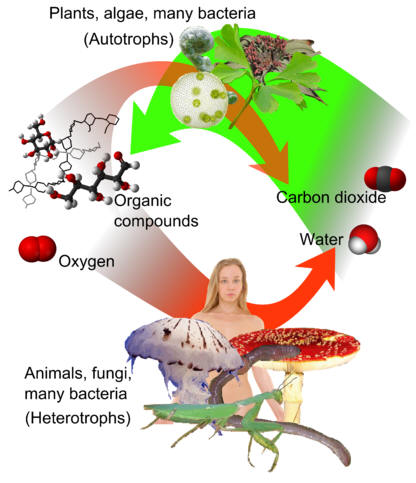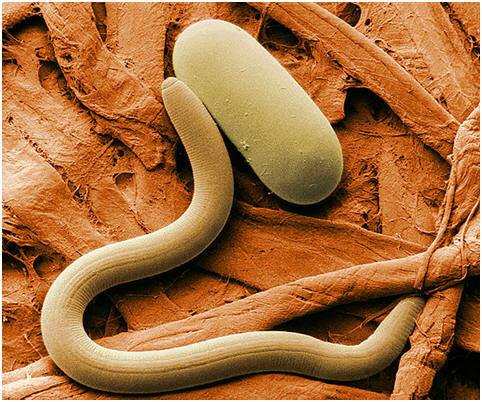Interactions
Starting with the most
basic of environmental interaction, as seen in the diagram to
the right, Allium sativum is a photoautotroph which means
it acquires it's food through a process known as photosynthesis. This is the process of combining water,
sunlight, and carbon dioxide to create nutritional organic
compounds for food. Oxygen is a pivotal byproduct of this
process for all aerobic respiring organisms. Without autotrophs
like garlic to deliver oxygen none of these organisms would
survive. In terms of other plants, competition for vital
resources are, for the most part, the extent of their
interaction. Insects like bees and butterflies help to disperse
pollen from plant to plant. Garlic's flowers attract these
pollinating insects. When they go from one plant to another the
pollen is spread, this creates higher genetic diversity and
successful reproduction.
photosynthesis. This is the process of combining water,
sunlight, and carbon dioxide to create nutritional organic
compounds for food. Oxygen is a pivotal byproduct of this
process for all aerobic respiring organisms. Without autotrophs
like garlic to deliver oxygen none of these organisms would
survive. In terms of other plants, competition for vital
resources are, for the most part, the extent of their
interaction. Insects like bees and butterflies help to disperse
pollen from plant to plant. Garlic's flowers attract these
pollinating insects. When they go from one plant to another the
pollen is spread, this creates higher genetic diversity and
successful reproduction.
Like many other plants, garlic has a symbiotic interaction with a fungus known as mycorrize. A member of the phylum glomeromycota, mycorrize can be found in the roots of most vascular plants. The fungus is known to increase the surface area of the plant's roots allowing it to more efficiently acquire water and nutrients from the soil. This is a mutually beneficial relationship between the plant and fungus due to the sharing of acquired resources and the resulting increases in growth.
Although, garlic plants have been
known to ward off
rabbits and moles(Wiki, 2012). In addition to humans, a wide
range of pests and fungal pathogens are consumers of garlic. The
most common of which are a variety of nematodes and several species
of insects. Furthermore, diseases known as purple leaf blotch (Alternaria
porri), pink root (Pyrenochaeta terrestris),white rot (Sclerotium
cepivorum) ,and various viral pathogens are also associated with
Allium sativum."Most garlic diseases are either soil- or
seed-borne and usually can be controlled with proper sequence and
planting disease-free seed"(Rosen et al, 2012). According to the
PROTA database on Allium sativum(2005), "leaf blotch is very
common when air humidity is high and when environmental factors,
like poor calcium nutrition and aluminium toxicity, increase plant
susceptibility". In agriculture, leaf blotch has been controlled
with various fungicidal sprays(PROTAdatabase, 2005). Pink root, on
the other hand is a soil borne disease, and it is normally kept
under control by crop rotations with 5 years without onion and
garlic(Rosen et al, 2012). Another disease known as "white rot (Sclerotium
cepivorum) include symptoms of premature yellowing and dying of
older leaves, stunting, and leaf tipburn, followed by destruction of
the root system, shoot dieback, and rotting of the bulb." (Rosen et
al, 2012). Viruses can also be found in many garlic strains, the
most common of which are known as potyviruses or onion yellow dwarf
virus (OYDV) and leek yellow stripe virus (LYSV) (PROTAdatabase,
2005). A variety of insects make up a significant body of garlic
pests. For example, Thrips tabaci, commonly known as onion
thrips are one of the most extensive garlic pests. They are sucking
insects that cause symptoms of whitish specks on the leaves (De La
Cruz and Garcia, 2007). According to Rosen et al, 2012, "Army worms
are caterpillars who lay eggs in large fuzzy masses. The resulting
larvae generally feed on the upper leaves of the garlic plant and
move to a new plant after defoliation". Another species of insect
pests are known as onion maggots. Their white
larvae can infect garlic plants. "Upon hatching, these maggots bore
into the root system causing yellowing and wilting in young garlic
plants" (Rosen et al, 2012). A similar parasite known as wireworms
are yellow/brown beetle larvae that can damage the roots and bulbs of
the plant (De La Cruz and Garcia, 2007). Perhaps the most important
parasite of garlic, according to the PROTA database on Allium
sativum, is a nematode known as the stem and bulb nematode.
Usually it infects the stem tissues first, this results in stunting
of the plants growth and the distinctive twisted and pale leaves
that are symptoms of the infection. At the arrival of this stage of
infection, rotting of the lower stem and base of the bulb occurs.
Often times, entire fields can deliver deformed and dying young
garlic plants (De La Cruz and Garcia, 2007). This is just an
overview of some of the diseases and parasites associated with
garlic. Agriculturally speaking, Allium sativum has a lot to
contend with in its quest for adult hood.
yellow/brown beetle larvae that can damage the roots and bulbs of
the plant (De La Cruz and Garcia, 2007). Perhaps the most important
parasite of garlic, according to the PROTA database on Allium
sativum, is a nematode known as the stem and bulb nematode.
Usually it infects the stem tissues first, this results in stunting
of the plants growth and the distinctive twisted and pale leaves
that are symptoms of the infection. At the arrival of this stage of
infection, rotting of the lower stem and base of the bulb occurs.
Often times, entire fields can deliver deformed and dying young
garlic plants (De La Cruz and Garcia, 2007). This is just an
overview of some of the diseases and parasites associated with
garlic. Agriculturally speaking, Allium sativum has a lot to
contend with in its quest for adult hood.
Human Interaction
On the other, perhaps more important side of interactions with garlic for humans, a vast amount of research suggests that Allium sativum holds promise in medicine across the board. Throughout history, human interactions with garlic have been subject to a positive spotlight. From the cloud of folklore surrounding garlic as an effective tool against black magic and its usual band of cronies to the real world health benefits in modern medicine. It is no wonder that garlic has been referred to in ancient writings from China, Egypt, Greece, and India (Milner, 1996). Historically we have seen garlic used in tea made to control colds, expectorant, diuretic, treatment of insect bites, headaches, and prevention of scurvy (Casey and Wynia, 2010).More recently, medicinal trials have provided evidence for the use of garlic in areas such as diabetes, food pathogen control, heart disease, and cancer prevention.
For example, conclusions of several published research articles suggests positive results for the use of garlic in treatments for heart disease. One article examined individuals with hypertension. Unknown to the test subjects, half were given a placebo treatment and the others were given the garlic treatment. After repeated trials and analysis the researchers concluded that the individuals who received the garlic treatment, showed a significant decrease in average blood pressure during the course of the intervention compared to the placebo group. This could mean big things in heart disease research in the future.(Ried, Frank, and Stocks, 2008)
In addition, a study that explored the possible
impact garlic has on diabetic individuals produced similar
beneficial results. Using rats as the test subjects, garlic extract
was administered several days prior to being induced with alloxan
and several days after. The introduction of alloxan in rats is known
to foster the development of diabetes and the rising of blood
glucose levels characteristic of this condition. From the experiment
the researchers concluded that when the garlic extract had been
received several days prior to the alloxan, the uncontrollable
increases in blood glucose were greatly reduced in most subjects.(Ojo,
Memudu, Akintayo and Akpan, 2012)
Another article from the Journal of Applied Microbiology, looked at how Garlic (Allium sativum) performs as an inhibitor against common food pathogens. More specifically they performed an experiment using Staphylococcus aureus, Salmonella typhi, Escherichia coli and Listeria monocytogene as the sample pathogens. The researchers inoculated brain heart infusion broths with different concentrations of the sample pathogens and added varying concentrations of garlic extract. The observable data was collected from the measuring of the turbidity of the bacterial cultures through the use of a spectrophotometer. From the data collected in this experiment it was concluded that garlic can serve as an effective inhibitor of these sample food pathogens. As a result of this effect, it was suspected that a component known as Allicin is responsible for the antimicrobial properties of garlic. This conclusion supports the use of garlic to increase shelf-life of food and limit the potential for food spoilage.(Kumar and Berwal, 1998)
In the hunt for advances in cancer research,
garlic has proven valuable as well. The primary strategy employed in
cancer research is identifying and understanding things called
carcinogens. A carcinogen is a substance that is known to be
directly involved in causing cancer. It does this by either having
an ability to damage an organism's genome or somehow disrupt the
metabolic processes of bodily cells. Results from several studies
show evidence of anticarcinogenic potential as a dietary component for garlic derived compounds. This evidence includes a proven
ability to prevent experimentally induced tumors in parts of the
body like skin, mammary, and colon tissues. To the right is a table
taken from the article that depicts these locations in the test
subjects. This success was explained by a hypothesis about the
general mechanism of action of dietary garlic compounds. It showed
changes in DNA repair performance and increases in the competence of
the immune system. Overall it was concluded that the use of garlic
as a dietary component could be useful in the prevention of a
variety of cancerous tumors (Milner, 1996). Picking up where
historical documentation of Allium sativum left off, you can
see that modern research has further expanded on medical knowledge
of garlic and highlighted the huge potential for further
breakthroughs.
for garlic derived compounds. This evidence includes a proven
ability to prevent experimentally induced tumors in parts of the
body like skin, mammary, and colon tissues. To the right is a table
taken from the article that depicts these locations in the test
subjects. This success was explained by a hypothesis about the
general mechanism of action of dietary garlic compounds. It showed
changes in DNA repair performance and increases in the competence of
the immune system. Overall it was concluded that the use of garlic
as a dietary component could be useful in the prevention of a
variety of cancerous tumors (Milner, 1996). Picking up where
historical documentation of Allium sativum left off, you can
see that modern research has further expanded on medical knowledge
of garlic and highlighted the huge potential for further
breakthroughs.
